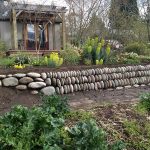The Power of Walls

Walls can do amazing things for a garden. Here in Eugene we rarely see free-standing walls enclosing spaces, but retaining walls abound. I’ve visited many hillside gardens in Eugene that would be just about impossible to cultivate or enjoy without the transformative power of terracing and retaining walls. Materials vary. Poured concrete is practical and can also look great in certain settings. Railroad ties and treated lumber are relatively cheap. Concrete blocks of various kinds are popular, but to me they always look like an opportunity missed. Continue reading